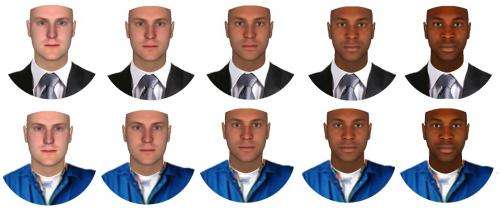Stereotypes and status symbols impact if a face is viewed as black or white

An interdisciplinary team of researchers from Tufts University, Stanford University and the University of California, Irvine has found that the perception of race can be altered by cues to social status as simple as the clothes a person wears.
Far from being a straightforward "read out" of facial features, say the researchers, racial categorization represents a complex and subtle process powerfully shaped by context and the stereotypes and prejudices we already hold.
"Looking the part: Social status cues shape race perception" appears in PLoS ONE published online September 26.
In the experiments, study participants were asked to determine the race of computerized faces. Faces accompanied by business attire were more likely to be seen as White, whereas faces accompanied by janitor attire were more likely to be seen as Black.
A novel hand-tracking technique -- which recorded participants' hand trajectories while using a mouse to select a racial category on the computer screen -- also revealed far more subtle influences of the stereotypical status cues.
Even when participants ultimately decided that a face with low-status attire was White or a face with high-status attire was Black, they showed that they were still drawn to the other race that was stereotypically tied to the status cue by moving the mouse slightly closer to that response before making their final decision.
The researchers then ran a series of computer simulations to show how the shifting of race perception by status cues naturally emerges in a system that is mathematically similar to a human brain -- so long as that system already associates Whites with high status and Blacks with low status.
"The study shows how the perception of a face is always a compromise between the visual cues before our eyes and the baggage we bring to the table, like the stereotypes we hold," says the study's lead author, Jonathan B. Freeman, a doctoral candidate in psychology at the Tufts Graduate School of Arts and Sciences.
The results highlight one of the possible mechanisms through which subtle and unconscious racism continues to occur.
"Racial stereotypes are powerful enough to trickle down to affect even basic visual processing of other people, systematically skewing the way we view our social world," Freeman says.
Status cues had the largest effects for the faces that were most racially ambiguous, a notable finding given recent and projected growth of the multiracial population in the United States.
More information: Freeman JB, Penner AM, Saperstein A, Scheutz M, Ambady, N. PLoS ONE. "Looking the part: Social status cues shape race perception." Published online September 26, 2011. doi:10.1371/journal.pone.0025107
















